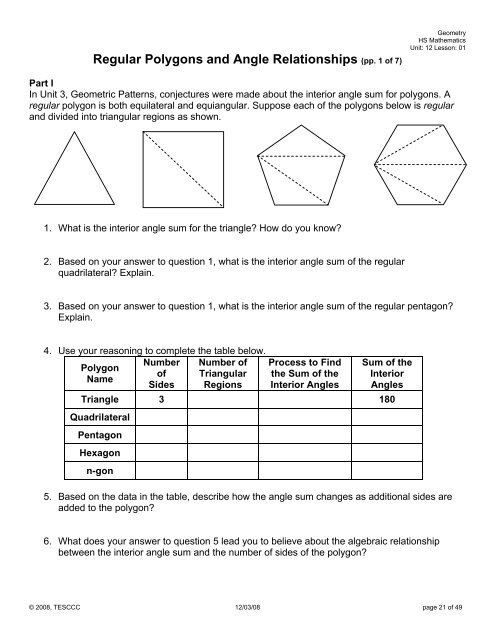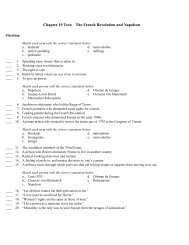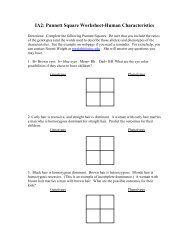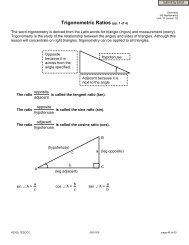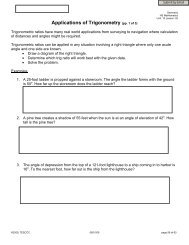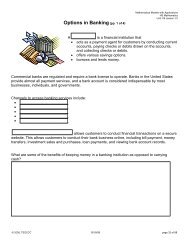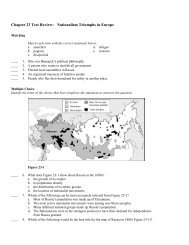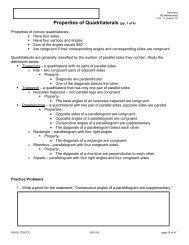Regular Polygons and Angle Relationships
Regular Polygons and Angle Relationships
Regular Polygons and Angle Relationships
You also want an ePaper? Increase the reach of your titles
YUMPU automatically turns print PDFs into web optimized ePapers that Google loves.
<strong>Regular</strong> <strong>Polygons</strong> <strong>and</strong> <strong>Angle</strong> <strong>Relationships</strong> (pp. 1 of 7)<br />
Geometry<br />
HS Mathematics<br />
Unit: 12 Lesson: 01<br />
Part I<br />
In Unit 3, Geometric Patterns, conjectures were made about the interior angle sum for polygons. A<br />
regular polygon is both equilateral <strong>and</strong> equiangular. Suppose each of the polygons below is regular<br />
<strong>and</strong> divided into triangular regions as shown.<br />
1. What is the interior angle sum for the triangle? How do you know?<br />
2. Based on your answer to question 1, what is the interior angle sum of the regular<br />
quadrilateral? Explain.<br />
3. Based on your answer to question 1, what is the interior angle sum of the regular pentagon?<br />
Explain.<br />
4. Use your reasoning to complete the table below.<br />
Polygon<br />
Name<br />
Number<br />
of<br />
Sides<br />
Number of<br />
Triangular<br />
Regions<br />
Process to Find<br />
the Sum of the<br />
Interior <strong>Angle</strong>s<br />
Sum of the<br />
Interior<br />
<strong>Angle</strong>s<br />
Triangle 3 180<br />
Quadrilateral<br />
Pentagon<br />
Hexagon<br />
n-gon<br />
5. Based on the data in the table, describe how the angle sum changes as additional sides are<br />
added to the polygon?<br />
6. What does your answer to question 5 lead you to believe about the algebraic relationship<br />
between the interior angle sum <strong>and</strong> the number of sides of the polygon?<br />
© 2008, TESCCC 12/03/08 page 21 of 49
<strong>Regular</strong> <strong>Polygons</strong> <strong>and</strong> <strong>Angle</strong> <strong>Relationships</strong> (pp. 2 of 7)<br />
Geometry<br />
HS Mathematics<br />
Unit: 12 Lesson: 01<br />
7. Based on the data in your table, write a function for the interior angle sum of a polygon in<br />
terms of the number of sides of a polygon.<br />
8. What is the significance of the coefficient of the variable that represents the number of sides of<br />
the polygon in your function? Explain.<br />
9. Sketch a graph of the function in question 7.<br />
10. What is the domain <strong>and</strong> range of the function you graphed in question 8?<br />
11. Are there parts of the graph that do not represent the pattern generated by the data in the<br />
table? Explain. What is an appropriate domain <strong>and</strong> range given the context of the problem<br />
setting? Explain your reasoning.<br />
12. Use the function you wrote in question 7 to predict the interior angle sum for a 12 sided<br />
polygon.<br />
13. Use the function you wrote in question 7 to determine the type of polygon that has an interior<br />
angle sum of 1080.<br />
14. Is it possible to have a polygon with an interior angle sum of 2430? Why or why not?<br />
© 2008, TESCCC 12/03/08 page 22 of 49
<strong>Regular</strong> <strong>Polygons</strong> <strong>and</strong> <strong>Angle</strong> <strong>Relationships</strong> (pp. 3 of 7)<br />
Geometry<br />
HS Mathematics<br />
Unit: 12 Lesson: 01<br />
Part II<br />
In the previous activity, you discovered the relationship between the interior angle sum of a regular<br />
polygon <strong>and</strong> the number of sides of the regular polygon. Recall that a regular polygon is both<br />
equiangular <strong>and</strong> equilateral.<br />
15. Sketch a regular triangle below. What is the interior angle sum for the triangle?<br />
a. Write <strong>and</strong> solve an equation to find the measure of each of the angles of the regular<br />
triangle.<br />
b. Suppose you extend one side of the triangle so that an exterior angle is formed. What is<br />
measure of the exterior angle formed? How do you know?<br />
c. Suppose you construct one exterior angle at each vertex. What is the exterior angle sum<br />
for the triangle? Explain your reasoning.<br />
16. Sketch a regular quadrilateral below. What type of quadrilateral did you sketch? What is the<br />
interior angle sum for the quadrilateral?<br />
a. Write <strong>and</strong> solve an equation to find the measure of each of the angles of the regular<br />
quadrilateral.<br />
b. Suppose you extend one side of the quadrilateral so that an exterior angle is formed. What<br />
is measure of the exterior angle formed? How do you know?<br />
c. Suppose you construct one exterior angle at each vertex. What is the exterior angle sum<br />
for the quadrilateral? Explain your reasoning.<br />
© 2008, TESCCC 12/03/08 page 23 of 49
<strong>Regular</strong> <strong>Polygons</strong> <strong>and</strong> <strong>Angle</strong> <strong>Relationships</strong> (pp. 4 of 7)<br />
Geometry<br />
HS Mathematics<br />
Unit: 12 Lesson: 01<br />
17. Repeat the procedure to find the measure of each of the interior <strong>and</strong> exterior angles of a<br />
regular pentagon, regular hexagon, regular heptagon, <strong>and</strong> regular octagon as well as the<br />
exterior angle sum. Record your data in the table below.<br />
Polygon<br />
Name<br />
Number of<br />
Sides, n<br />
Sum of the<br />
Interior<br />
<strong>Angle</strong>s<br />
(n – 2)180<br />
Triangle 3 180<br />
Quadrilateral<br />
Pentagon<br />
Hexagon<br />
Heptagon<br />
Octagon<br />
n-gon<br />
Process to<br />
Find the<br />
Measure of<br />
an Interior<br />
<strong>Angle</strong><br />
Measure of<br />
Each Interior<br />
<strong>Angle</strong><br />
Measure of<br />
Each Exterior<br />
<strong>Angle</strong><br />
Exterior<br />
<strong>Angle</strong> Sum<br />
(one angle<br />
at each<br />
vertex)<br />
a. Describe the process for finding the measure of an interior angle of a regular polygon.<br />
b. Describe the process for finding the measure of an exterior angle of a regular polygon.<br />
c. Based on the data in the table, describe how the measure of an interior angle changes as<br />
the number of sides of the regular polygon changes. What does this lead you to believe<br />
about the relationship between the measure of an interior angle of a polygon <strong>and</strong> the<br />
number of sides of a regular polygon?<br />
© 2008, TESCCC 12/03/08 page 24 of 49
<strong>Regular</strong> <strong>Polygons</strong> <strong>and</strong> <strong>Angle</strong> <strong>Relationships</strong> (pp. 5 of 7)<br />
Geometry<br />
HS Mathematics<br />
Unit: 12 Lesson: 01<br />
18. Use your graphing calculator <strong>and</strong> the list editor to analyze the data from your table.<br />
a. Enter the number of sides of the polygon into L1 <strong>and</strong> the measure of an interior angle into<br />
L2. Create a scatterplot of your data using the STAT PLOT menu of your graphing<br />
calculator. Sketch the graph below.<br />
b. Enter the expression for the measure of an interior angle of a regular n-gon from your table<br />
as Y1 <strong>and</strong> graph it along with the scatterplot. Sketch the graph along with your scatterplot in<br />
18.a.<br />
c. Generate a table of values for Y1 using your graphing calculator. Start your table at zero<br />
<strong>and</strong> increment the table by 1. How do the values in the table compare to the values in your<br />
data table?<br />
d. Based on your answer to 18.c <strong>and</strong> given the context of the measure of an interior angle of a<br />
regular polygon as a function of the number of sides of the regular polygon, what is an<br />
appropriate domain <strong>and</strong> range? Explain your reasoning.<br />
e. Use the function from your table <strong>and</strong> that you graphed as Y1 in the calculator to find the<br />
following values. What is the measure of an interior angle of a regular 750-gon? <strong>Regular</strong><br />
1000-gon? <strong>Regular</strong> 10000-gon? <strong>Regular</strong> 10500-gon?<br />
f. Based on your answers in 18.e, what is the suggested maximum value of the function?<br />
g. Suppose the function takes on a value of 180°, find the input value (number of sides of the<br />
polygon). Explain the meaning of your answer both algebraically <strong>and</strong> geometrically.<br />
© 2008, TESCCC 12/03/08 page 25 of 49
<strong>Regular</strong> <strong>Polygons</strong> <strong>and</strong> <strong>Angle</strong> <strong>Relationships</strong> (pp. 6 of 7)<br />
Geometry<br />
HS Mathematics<br />
Unit: 12 Lesson: 01<br />
h. Describe the measure of an interior angle of a regular polygon as a function of the number<br />
of sides of the polygon verbally.<br />
i. Based on your previous answers <strong>and</strong> your knowledge of the relationship between the<br />
interior angle of a polygon <strong>and</strong> its exterior angle, describe the measure of an exterior angle<br />
of a regular polygon as a function of the number of sides of the regular polygon. Explain<br />
your reasoning.<br />
j. Create a scatterplot of the measure of an exterior angle of a regular polygon versus the<br />
number of sides of the regular polygon using the graphing calculator. Sketch the graph<br />
below.<br />
k. Enter the expression for the measure of an exterior angle of a regular n-gon from your table<br />
as Y2 <strong>and</strong> graph it along with the scatterplot. Sketch the graph along with your scatterplot in<br />
18.j.<br />
l. Given the context of the situation, describe an appropriate domain <strong>and</strong> range for the<br />
function.<br />
© 2008, TESCCC 12/03/08 page 26 of 49
<strong>Regular</strong> <strong>Polygons</strong> <strong>and</strong> <strong>Angle</strong> <strong>Relationships</strong> (pp. 7 of 7)<br />
Geometry<br />
HS Mathematics<br />
Unit: 12 Lesson: 01<br />
19. Suppose a regular polygon has an interior angle that measures 150°. Write an equation <strong>and</strong><br />
find the number of sides of the polygon. What is the measure of one of its exterior angles?<br />
Explain your reasoning.<br />
20. Suppose a regular polygon has an exterior angle that measures 20°. Find the measure of one<br />
of its interior angles <strong>and</strong> the number of sides of the polygon. Explain your reasoning.<br />
21. Is it possible for a regular polygon to have an interior angle that measures 175°? Why or why<br />
not?<br />
© 2008, TESCCC 12/03/08 page 27 of 49


